History
Frank Vining: a personal recollection
Frank Vining (1924–89) was an influential teacher of ceramics and the guiding force behind the development of the internationally renowned centre of ceramics education at Cardiff College of Art in the period 1950-81. In this essay, Paul Vining recalls his father’s contribution to ceramics education during that period.

Early years
Frank Vining was born on Leap Day 1924, in Aberfan, in a house later swept away by the tip disaster of 1966. Attending Aberdare Boys’ County School, the young Frank was encouraged in his art classes by the headmaster and in 1941 won a scholarship to the School of Art in Cardiff. There, he studied under Ceri Richards, the wartime head of painting. On his return from war service in the Royal Navy, Frank was able to complete his course, the principal at the time (James C Tarr) recording ‘As a draughtsman and illustrator he is extremely gifted, and his painting, lettering and design are of a very high order...Mr Vining’s work in all of these [crafts] is of extremely high quality, his pottery in particular being very good.’ At the same time, Ceri Richards himself wrote: ‘Vining possesses considerable talent in draughtsmanship and on his creative side showed real promise and was producing very good and interesting work indeed.’

Frank Vining demonstrating at Barry Summer School, 1963
National Diploma in Design ceramics
Frank Vining was appointed a lecturer at Cardiff College of Art in 1950 and took that opportunity to develop his interest in pottery, running popular day and evening classes. Although the pottery of that time was fairly traditional, its standard was high: the curator of the Glynn Vivian Art Gallery recording: ‘The earthenware which is being made in Cardiff made an outstanding impression with its craftsmanship and agreeably humorous design…’ (David Bell, The Artist in Wales, George G Harrap & Co Ltd, London 1957).
The early 1960s were a turning point. In the world of ceramics, in keeping with the spirit of the times, a more experimental approach was afoot, with a blurring of the boundaries between pottery and sculpture. It was a formative time for Frank. In 1962, he taught alongside James Tower at the renowned Barry Summer School. At the 1963 summer school, Frank was joined as co-tutor by Helen Pincombe and, in 1964, by Ruth Duckworth. All three were influential potters in Britain at the time, Ruth Duckworth and James Tower in particular developing international reputations. These influences were apparent in the work undertaken in the ceramics department of the college in the early 1960s, in the period leading up to graduate recognition. In particular, there was an emphasis on architectural ceramics and sculptural forms as well as studio pottery.
DipAD/BA ceramics
In the early 1960s, the system of art education in Britain was transformed. The NDD was replaced by a new degree-level qualification, the Diploma in Art and Design. Before being allowed to award the diploma, colleges were subject to rigorous assessment and there was consternation when, in 1963, Cardiff College of Art failed to attain DipAD status in Fine Art. Later that year, Cardiff City Council made a far-sighted move when Tom Hudson was appointed director of studies, bringing with him from Leicester College of Art a team of artists who were at the cutting edge of contemporary practice.
It is interesting to note the involvement of sculptors in the early development of the ceramics course at Cardiff. Frank Roper, the vice-principal, who originally taught pottery there in the 1940s, was a sculptor with a particular expertise in ecclesiastical work. At the time of DipAD recognition, apart from Frank Vining – whose formal training had been as a painter rather than a potter – the department included three sculptors: Geoffrey Milsom, whose own work was largely clay-based, and two of Tom Hudson’s newcomers: Mervyn Baldwin and Laurence Burt. This group was instrumental in developing the radical ceramics course that obtained DipAD accreditation in 1966. This new status had a substantial practical spin-off in terms of better equipment, purpose-built accommodation and the appointment of new staff.
During the 1960s and 1970s the reputation of the ceramics department at Cardiff flourished. This was due not only to Frank’s leadership, but also to the remarkable array of practising ceramicists that he attracted to work there. Many of them stayed for long periods and each played a distinctive role.
Alan Barrett-Danes, who came from a family of country potters, trained as a pottery designer in Stoke-on-Trent and became renowned as a specialist in glaze technology, as well as a practitioner. Tony Franks subsequently became head of ceramics (and later emeritus professor) at Edinburgh College of Art and is a past president of the International Academy of Ceramics. Michael Hose, who studied at the Royal College of Art and worked at Josiah Wedgewood & Son Ltd, brought experience in industrial and product design. He helped to initiate the MA course and, from 1982 until 2001, was its first head, to be followed by Peter Castle. Peter Starkey, who had studied at Harrow College of Art, brought valuable workshop experience, having run the Dartington Pottery Training Workshop in Devon, and eventually succeeded Frank Vining as head of the BA course from 1982-2001. Geoffrey Swindell and Nicholas Homoky, also graduates of the Royal College of Art, developed international reputations for their work, which is represented in important collections. Graham Williamson, who is a graduate of the college, served as a glaze technician in the department for 30 years, before setting up his own pottery in 2009.
In addition to the permanent staff, students on the course benefitted from an extensive programme of visiting lecturers – Dan Arbeid, Ian Auld, Gordon Baldwin, Glenys Barton, Michael Casson, Garth Clark, Walter Keeler, Victor Margrie, Jacqueline Poncelet, James Tower and Robin Welch among others – many of whom are among the most gifted and influential practitioners of their generation.
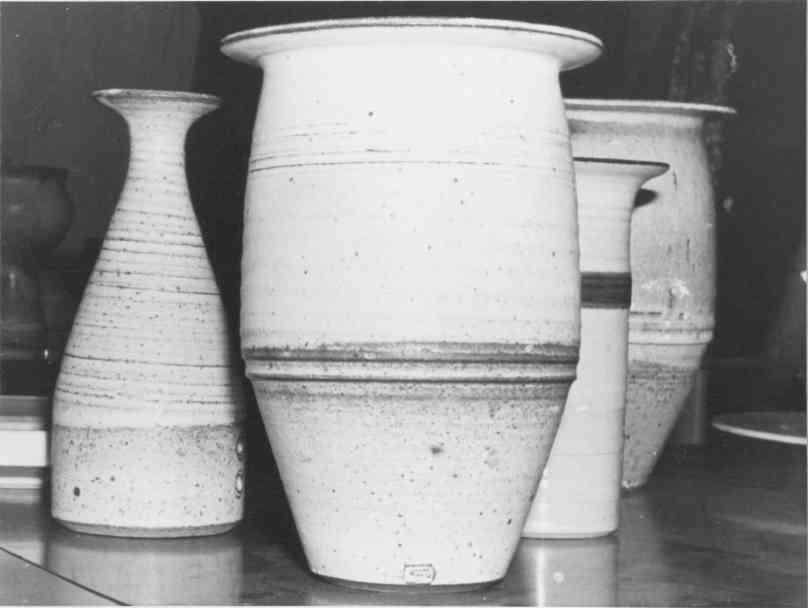
Exhibition installation, 1963
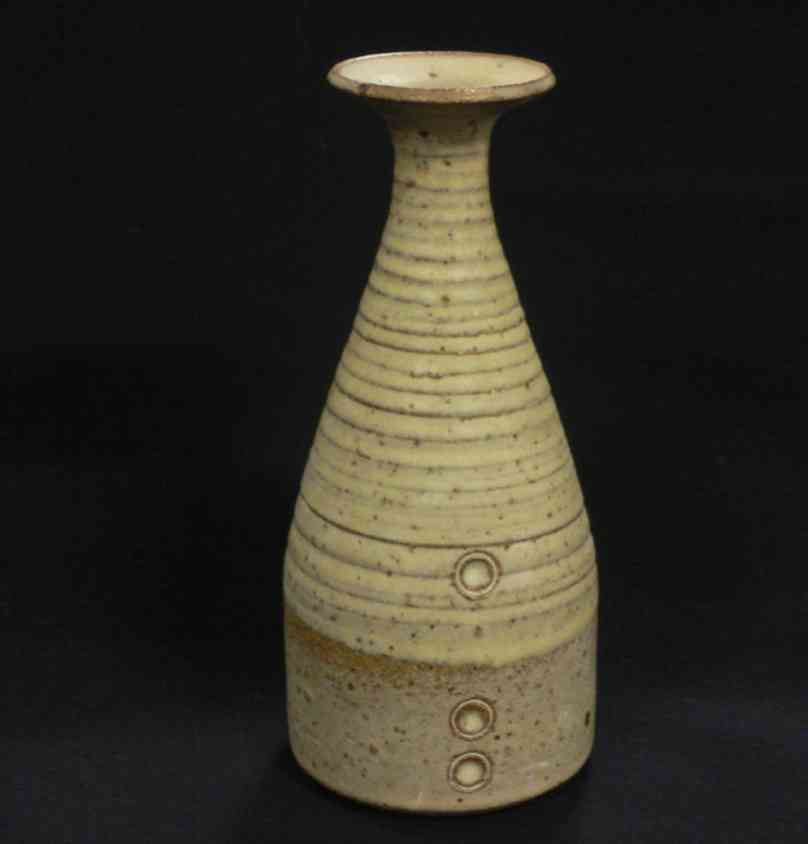
Stoneware bottle, early 1960s
Course philosophy
An outward-looking approach was encouraged. Student exhibitions were not confined to end-of-year college shows; exhibitions were held at other venues. Significantly, in 1975 the first British International Ceramics Symposium was held at the college, directed by Tony Franks. It is generally accepted that the hallmark of the Cardiff ceramics course was its ‘openness’, as was noted by the curators of an exhibition in 2005: ‘Art colleges or departments often develop a house style under the influence of strong personalities on the teaching staff but there has never been a dominant style in Cardiff. Quite the opposite, everyone who I have talked to characterises the course as ‘open’ and liberal and encouraging students to develop in independent ways.’ (Jo Dahn and Moira Vincentelli, Bodyworks: figurative ceramics with a Cardiff connection, A School of Art Publication, June 2005).
This openness was achieved by design. As early as 1964, in a BBC programme, A Place for the Potter, Frank Vining had outlined the fundamental purpose of the course as follows: ‘...to provide an education through art; in the case of the pottery student, to provide an education through personal development within the field of ceramics.’ In the college prospectus, the aims of the course were described thus: ‘The course provides the opportunity, facilities and environment for personal exploration, development and achievement through ceramic and other media, and encourages the student to evolve his own personal direction and philosophy.’
The course philosophy was aptly summarised by an independent reviewer (Peter Jones of the Welsh Arts Council) of the 1974 diploma show: ‘The course at Cardiff College of Art allows for extreme varieties of motivation in the students. Individuals can exercise choice through experiments based on the whole range of ceramic technology and often work is produced as a result of pushing techniques to new limits... Although individual freedom could be regarded as a main aim of Cardiff College of Art and Design, the technical disciplines are rigorous enough to prepare its trainees for any future exploitation of ceramics.’ The following year, the same reviewer said: ‘It isn’t only the variety of high-level technical skills that impresses at Cardiff. The first and lingering impression is that the ceramics course, like others in the college, encourages a maximum of individuality. One is constantly aware of the benefits and validity of ten years emphasis on “creative technology” and the provision of real flexibility between different areas of study...The college is particularly good at recognising and fostering special and unique talents...’
Gordon Baldwin was the external examiner for the BA course in the late 1970s. His contemporaneous comments are instructive as to the ambience and philosophy of the course during Frank’s last years as head: ‘The Department sets itself high standards in accord with an Honours Degree. There is no “house style” and the work covers a broad spectrum each area and direction given proper critical encouragement by the staff. It is interesting how the environment of Cardiff has a positive effect on the students’ work and outlook.’
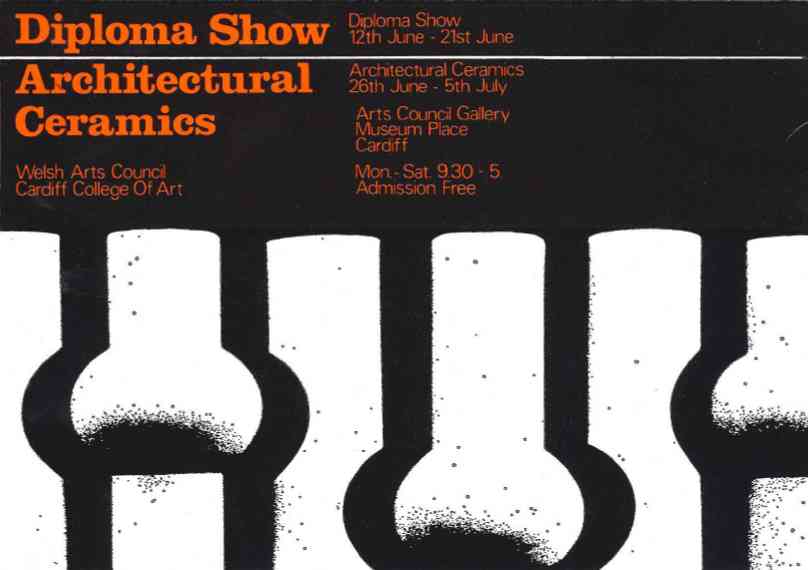
College of art poster, 1969
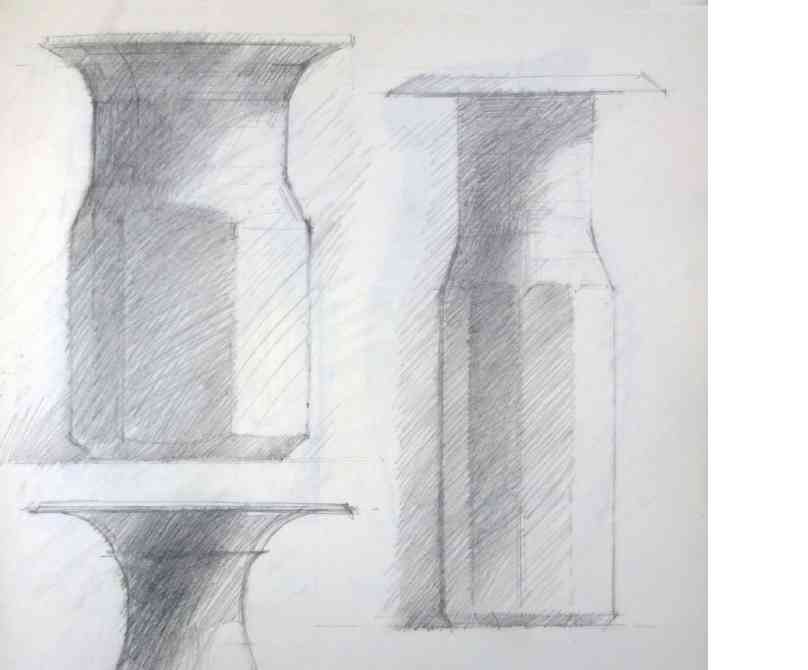
Extract from drawing book, 1970s/80s
MA ceramics
At the time of the 1976 quinquennial review by the Council for National Academic Awards, the reputation of the department was such that further developments were being mooted. Chief among them was the idea of an MA course in ceramics, of which there were only two others in the UK at the time (the Royal College of Art and Stoke-on-Trent College of Art). Work on devising the MA course started in 1977; it was validated by CNAA in 1981 and commenced in 1982. Having flourished initially under the leadership of Michael Hose, it is by now one of the longest established Masters’ programmes in ceramics in the UK. Its 25th anniversary was marked by an exhibition when it was aptly described by the critic David Whiting, as ‘…very much a jewel in the national crown.’
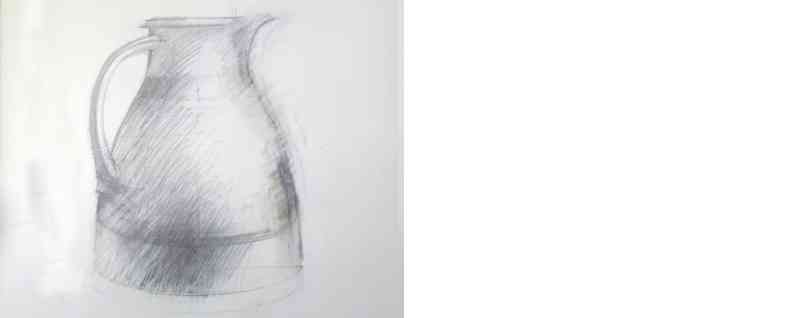
Extract from drawing book, 1970s/80s
‘Retirement’
In 1980, Frank underwent major surgery and was lucky to survive. Within a year he had been granted early retirement on ill-health grounds, having completed 31 years’ continuous service at the college. For the next few years, Frank continued to teach part-time, initially on the MA programme and, later at the South Glamorgan Institute of Higher Education, where he worked alongside Trevor Worton. Frank’s inputs there were broadly based, contributing to courses in objective drawing, mark-making, form and structure, and colour. Trevor noted that Frank’s sensitivity to and experience of a wide range of materials and techniques was welcomed, as was his experimental and creative approach and his empathy with staff and students.
For many years Frank was a leading member of the South Wales Potters, regularly acting as a selector for members’ exhibitions and facilitating workshops at the college of art; in 1977 he was invited to become an honorary vice-president.
Through his work with the Welsh Arts Council, Frank continued to support ceramic and craft activity in Wales. He was instrumental in getting the council to fund professional potters and to enable makers to spend time in developing an aspect of their practice in the ceramics department: recipients included Oldrich Asenbryl, Madoline Keeler, Jim Malone and Takeshi Yasuda. Writing, in 1983, about the state of the crafts in Wales, Derrick Turner was able to say: ‘Probably the most significant craft practice in Wales is ceramics. The field is wide. There are many runners of good pedigree dispersed across the terrain. Cardiff has for years been the academic base for inventiveness. It was Frank Vining’s stable-team that gave the vitality and vision...’ (Derrick E Turner, Makers of Wales in Wales: The Visual Arts in Wales, Arts Review Magazine, June 1983).
Frank Vining died on 27 October 1989, aged 65. His obituary, by Alan Barrett-Danes, appeared in Crafts, Ceramic Review and Crefft. Alan wrote:
‘Frank Vining… founded the Ceramic School at Cardiff, which was to become known and highly regarded both here and abroad. His strength, integrity and total commitment was the foundation of the success of the Ceramic Department at Cardiff. After twenty years of successfully running the BA(Hons) Degree Course, and close involvement with CNAA, his career culminated in the successful validation of the MA Course in 1981… The loss of Frank will be felt by so many people in the educational and professional world of ceramics. The countless students that passed through Cardiff and experienced first hand his warmth, compassion, understanding and above all his humour – these young people are a lasting memorial to him. Frank Vining was a man of rare qualities who will be greatly missed.’
Frank Vining’s ceramics are represented in public as well as private collections including those at Aberystwyth University, National Museum Wales (schools collection) and the Camberwell ILEA Collection.
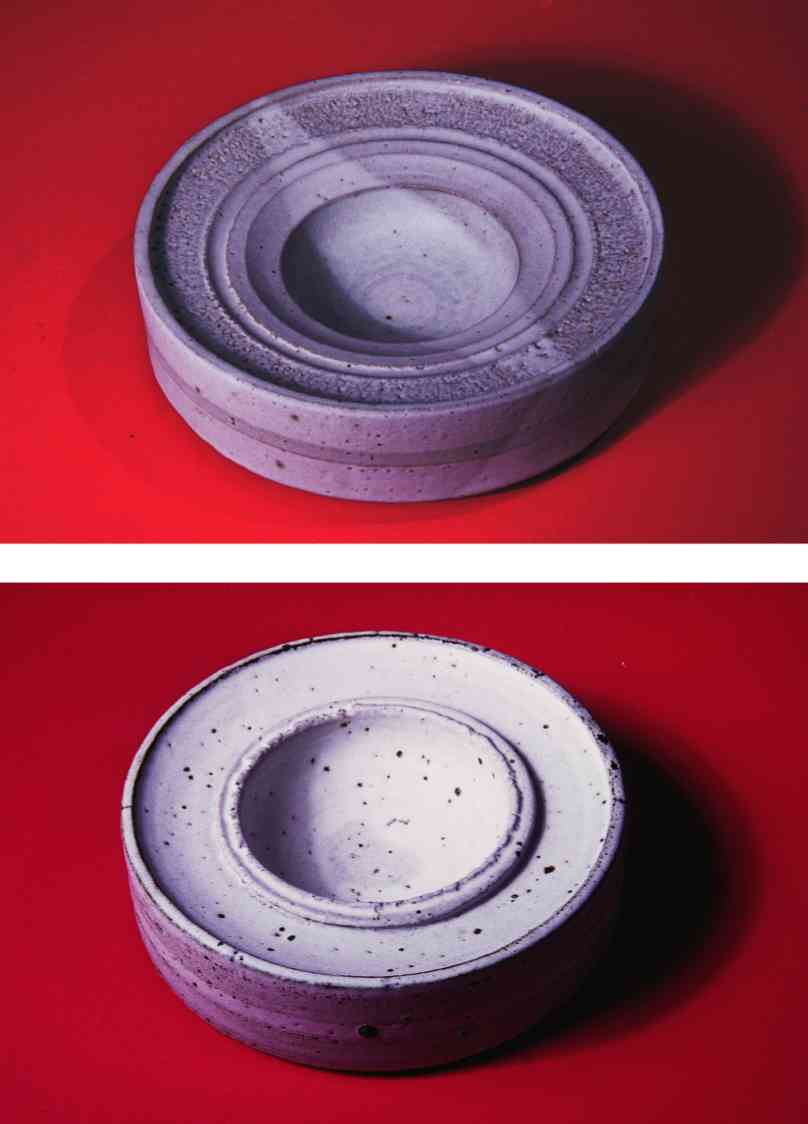
Two stoneware disc forms, mid 1960s



